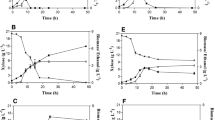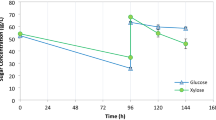Abstract
Candida shehatae NCL-3501 utilized glucose and xylose efficiently in batch cultures. The specific rate of ethanol production was higher with mixtures of glucose and xylose (0.64–0.83 g g−1 cells d−1) compared to that with individual sugars (0.38–0.58 g g−1 cells d−1). Although the optimum temperature for growth was 30°C, this strain grew and produced appreciable levels of ethanol at 45°C. A stable ethanol yield (0.40–0.43 g g−1 substrate utilized) was obtained between 10 g L−1 and 80 g L−1 of initial xylose concentration. Conversion efficiency was further improved by immobilization of the cells in calcium alginate beads. Free or immobilized cells ofC. shehatae NCL-3501 efficiently utilized sugars present in rice straw hemicellulose hydrolysate, prepared by two different methods, within 48 h. Ethanol yields of 0.45 g g−1 and 0.5 g g−1 from autohydrolysate, and 0.37 g g−1 from acid hydrolysate were produced by free and immobilized cells, respectively.
Similar content being viewed by others
References
Abbi M. 1994. A study of fermentation of pentose sugars to ethanol byCandida shehatae, MSc Thesis, University of Delhi, New Delhi, India.
Dubois M, KA Gilles, IK Hamilton, PA Rebers and F Smith. 1956. Colorimetric method for determination of sugars and related substances. Anal Chem 28: 350–356.
du Preez JC, M Bosch and BA Prior. 1986. The fermentation of hexose and pentose sugars byCandida shehatae andPichia stipitis. Appl Microbiol Biotechnol 23: 228–233.
Enari T-M and M-L Suihko. 1984. Ethanol production by fermentation of pentoses and hexoses from cellulosic materials. Crit Rev Biotechnol 1: 229–239.
Fan LT, MM Gharpuray and HY Lee. 1981. Evaluation of pretreatments for enzymatic conversion of agricultural residues. Biotechnol Bioeng Symp 11: 29–45.
Ferrari MD, E Neirotti, C Albornoz and E Saucedo. 1992. Ethanol production from eucalyptus wood hemicellulose hydrolysate byPichia stipitis. Biotechnol Bioeng 40: 753–759.
Ghosh P and A Singh. 1993. Physicochemical and biological treatments for enzymatic/microbial conversion of lignocellulosic biomass. Adv Appl Microbiol 39: 295–333.
Grootjen DRJ, LHHM Meijlink, RGJM van der Lans and KChAM Luyben. 1990. Cofermentation of glucose and xylose with immobilizedPichia stipitis andSaccharomyces cerevisiae. Enzyme Microb Technol 12: 860–864.
Jeffries TW. 1982. A comparison ofCandida tropicalis andPachysolen tannophilus for conversion of xylose to ethanol. Biotechnol Bioeng Symp 12: 103–114.
Jeffries TW. 1984. Emerging technology for fermentingd-xylose. Trends Biotechnol 3: 208–212.
Kiersten M and C Bucke. 1977. The immobilization of microbial cells, subcellular orgenelles and enzymes in calcium alginate gels. Biotechnol Bioeng 19: 387–397.
Kuhad RC and A Singh. 1993. Lignocellulose biotechnology: current and future prospects. Crit Rev Biotechnol 13: 151–172.
Laplace JM, JP Delegenes, R Moletta and J Navarro. 1993. Effect of culture conditions on the co-fermentation of glucose and xylose mixture to ethanol by a mutantSaccaromyces diastaticus associated withPichia stipitis. Appl. Microbiol Biotechnol 39: 760–763.
Maleszka R and H Schneider. 1984. Concurrent production and consumption of ethanol by cultures ofPachysolen tannophilus growing ond-xylose. Appl Environ Microbiol 44: 909–913.
Mishra P and A Singh. 1993. Microbial pentose utilization. Adv Appl Microbiol 39: 91–152.
Mörsel J-T and T Heyer. 1990. A colorimetric method for the determination of glycerides. Die Nahrung-food 34: 287–288.
Nishikawa N, R Sutcliffe and JN Saddler. 1988. The influence of lignin degradation products on xylose fermentation. Appl Microbiol Biotechnol 27: 549–552.
Schneider H. 1989. Conversion of pentoses to ethanol by yeasts and fungi. Crit Rev Biotechnol 9: 1–40.
Skoog K and B Hahn-Hägerdal. 1988. Xylose fermentation. Enzyme Microb Technol 10: 66–80.
Standing CN, AG Fredrickson and HM Tsuchia. 1972. Batch and continuous transient for two substrate system. Appl Microbiol 23: 354–359.
Author information
Authors and Affiliations
Rights and permissions
About this article
Cite this article
Abbi, M., Kuhad, R.C. & Singh, A. Fermentation of xylose and rice straw hydrolysate to ethanol byCandida shehatae NCL-3501. Journal of Industrial Microbiology 17, 20–23 (1996). https://doi.org/10.1007/BF01570143
Received:
Accepted:
Issue Date:
DOI: https://doi.org/10.1007/BF01570143




